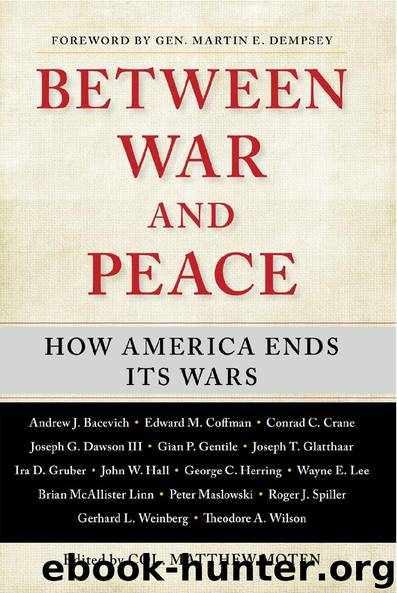Between War and Peace by Col. Matthew Moten

Author:Col. Matthew Moten
Language: eng
Format: epub
Publisher: Free Press
Published: 2011-07-15T00:00:00+00:00
THE MEUSE-ARGONNE OFFENSIVE
SEDAN-VERDUN AND VICINITY
September-October 1918
Pétain had a point: the challenge was daunting. Five of the attack divisions had never seen combat, and many more troops were not well trained. Shortly before the battle, one of the experienced divisions received 4,000 replacements who had been drafted only six weeks earlier. Moreover the logistical requirements would have challenged a thoroughly experienced army. Using only three roads mostly at night, 600,000 Americans in fifteen divisions had just two weeks to relieve 220,000 Frenchmen holding the Meuse-Argonne lines. The staff officer who planned and supervised moving 400,000 American troops and supplies from the St. Mihiel sector was Col. George C. Marshall.
The operational movement to the Meuse-Argonne worked, but the American assault plan unraveled on the first day, September 26. Rather than advancing nine miles to the Hindenburg Line, the two divisions in the Argonne Forest gained only a mile. Three others in more open terrain advanced three miles and penetrated the second line. The Germans, however, held the key high ground at Montfaucon until the next day. On that day the British launched their offensive on the western end of the salient. Within the next two days, the British, French, and Belgians commenced two more offensives so that the entire pincer movement was hammering the Germans. The two predominantly British attacking forces (including the 27th and 30th American divisions) engaged the largest number of Germans, and in one attack quickly penetrated the Hindenburg Line in their area. The Germans were able to reinforce their troops facing the Americans, but they had to maintain sufficient troops to combat the Allied offensives.
Pershing later wrote, “The battle from October 1st to the 11th involved the heaviest strain on the army and on me.” 4 In twelve days of fighting early in October, the 1st Division, most veteran in the AEF, drove a wedge into the German defense that enabled three other divisions to clear the Argonne Forest. Their effort cost the 1st Division 8,200 casualties, the heaviest losses of any American division in the battle. All told, the AEF required three weeks of enervating combat to penetrate the Hindenburg Line. Hard fighting against experienced leaders and determined troops in good defensive positions produced heavy casualties and severe stresses on the Americans. Then there was the difficulty of sustaining the attack with troops, artillery, and supplies along only three roads into the sector. Cold, rainy weather, constant combat, and scant food and water combined to lower morale. Junior officers and noncommissioned officers, many of whom had been in uniform less than a year, lacked the leadership skills to control their men in such conditions. The First Army suffered as many as 100,000 stragglers by mid-October.
Pershing was aware of these problems, but he had little patience with allies who expressed their doubts about American fighting abilities. On October 1, Marshal Foch sent his chief of staff to meet with Pershing and suggest that he turn over much of his army to the French. Not surprisingly Pershing was enraged, and Foch withdrew the suggestion.
Download
This site does not store any files on its server. We only index and link to content provided by other sites. Please contact the content providers to delete copyright contents if any and email us, we'll remove relevant links or contents immediately.
| Archaeology | Essays |
| Historical Geography | Historical Maps |
| Historiography | Reference |
| Study & Teaching |
Underground: A Human History of the Worlds Beneath Our Feet by Will Hunt(12024)
Sapiens by Yuval Noah Harari(5294)
Navigation and Map Reading by K Andrew(5111)
The Sympathizer by Viet Thanh Nguyen(4305)
Barron's AP Biology by Goldberg M.S. Deborah T(4099)
5 Steps to a 5 AP U.S. History, 2010-2011 Edition (5 Steps to a 5 on the Advanced Placement Examinations Series) by Armstrong Stephen(3689)
Three Women by Lisa Taddeo(3354)
Water by Ian Miller(3128)
The Comedians: Drunks, Thieves, Scoundrels, and the History of American Comedy by Nesteroff Kliph(3039)
Drugs Unlimited by Mike Power(2545)
A Short History of Drunkenness by Forsyth Mark(2233)
DarkMarket by Misha Glenny(2159)
The House of Government by Slezkine Yuri(2159)
And the Band Played On by Randy Shilts(2129)
The Library Book by Susan Orlean(2042)
Revived (Cat Patrick) by Cat Patrick(1963)
The Woman Who Smashed Codes by Jason Fagone(1929)
Birth by Tina Cassidy(1864)
The Absolutely True Diary of a Part-Time Indian by Sherman Alexie(1859)
